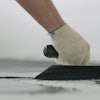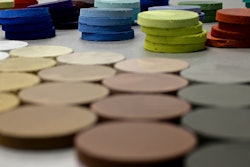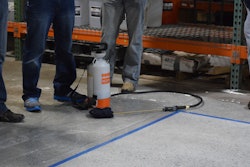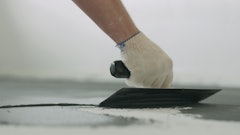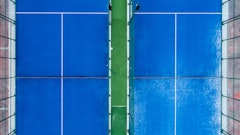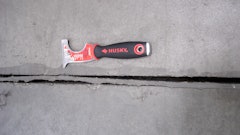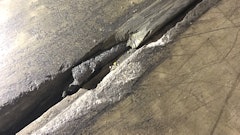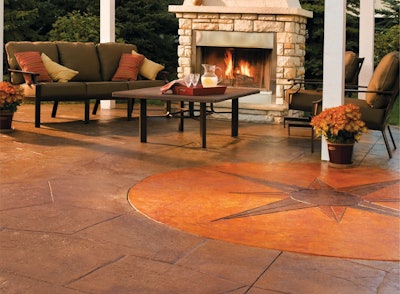
Let’s take a closer look at three different product types that help you turn your concrete surface into an amazing piece of art — dyes, stains, and pigments.
Dyes
Dyes can be defined as a coloring material or matter for imparting a particular hue to a surface. Dyes are a great way to color existing slabs of concrete and they offer a wide range of color options which will dry very quickly.
The raw form of a dye is a super fine powder that depending on manufacturing can be dispersed in a solvent or water. True dyes are not UV stable.
“Recently, manufacturers have used the term ‘dye’ for exterior pigments,” says Brett Cline, Sales Manager, Super-Krete of Texas. “These special ‘exterior dyes’ or pigments come in vibrant colors as well and are UV stable.”
Stains
Unlike dyes, concrete stains are generally classified into three categories: film-forming, penetrating and acid stains. All three types of stains come in a variety of colors, tints, shades and textures, but each uses different technology to create distinct decorative looks.
Film-forming stains have been around the longest and are still very common today. Like paint, film-forming stains simply coat or lay on top of a concrete surface to add color to a concrete surface. However, over time exposure to weather, traffic, chemicals and other harmful elements will cause film-forming stains to fad, peel or flake.
A more permanent alternative to film-forming stains are penetrating stains, which are designed to literally penetrate deeper into the pores of concrete and bond to the concrete. The water-based, polymer-bonded technology in penetrating stains minimizes the possibility of it fading, peeling or flaking while being VOC-friendly. In addition, penetrating stains are available in an almost endless assortment of tints and shades ranging from very light translucent colors to bright and bold solid colors. Typically water-based and user friendly, water-based penetrating stains can often be mixed together to create new colors without any adverse effects, they are often translucent and do not hide surface defects or flaws.
While both film-forming and penetrating stains rely on color pigments to alter the decorative appearance of concrete, acid stains chemically react with the minerals in concrete to generate a natural-looking marble appearance by physically etching the surface. Acids stains are slightly more expensive, and require more safety precautions and experience to apply than the film-forming and penetrating stains.
Pigments
Pigments impart black, white or a color to other materials. Typically, pigments are available as a powdered substance that is mixed with a liquid in which it is relatively insoluble and used to impart color to coating materials (such as paints) or to inks, plastics, and rubber.
As it relates to coloring concrete, the main type of pigment used in coloring concrete is Synthetic Iron Oxide. In manufacturing these minerals different colors are produced. They can either be left in their original powder form or dispersed into a liquid to create liquid pigments.
Surface preparation
Before applying any of these products it’s critical the concrete surface is thoroughly cleaned and free of any contaminants, and in the case of penetrating stains, the surface should be porous and profiled enough to accept a stain.
“There are a variety of effective methods for cleaning concrete including pressure washing, stain removers, mild cleaners, etchers and degreasers,” notes Paul Luecke, Vice President of Coatings for The QUIKRETE Companies.
Dyes — The most common method of applying dye is to disperse the dye powder in acetone and spray a fine mist over the concrete surface.
“Using acetone will cause the dye to dry very quickly which will allow you to introduce more colors if desired and seal the surface right away,” Cline says. “Dyes will also get darker the more you spray, so one color of dye will mottle by spraying it randomly over the surface.”
Cline offers the following best practices when applying these products:
- Always do a mock up or sample area before doing the whole job for color consistency, etc. Sealers will enhance color, be sure the customer sees the color sealed vs unsealed.
- Dyes will highlight existing stains and imperfections of the concrete. Make sure you educate the buyer.
- If spraying, always start and stop in a container. Not doing so will cause you to drip on the floor. The dye dries too fast to eliminate the drip marks.
- 4. Introducing saw cuts to the floor will help you fix any coloring mishaps. It’s much easier to fix a three inch by three inch square than the whole room.
Film-forming stains — The film-forming stain can be applied with a plastic sprayer, roller or brush being sure to avoid any pooling or dripping in order to achieve a consistent and uniform look.
“When using a plastic sprayer hold the wand one to two feet from the surface and move in circular motion,” Luecke says. “When using a roller or brush, make smooth, even strokes in one direction while keeping a wet edge to avoid streaking.”
Once the film-forming stain has dried for 24 hours, a sealer can be applied for added protection
Penetrating stains – When applying penetrating stains, the concrete surface must be void of any paint, stain, coatings or sealers and thoroughly clean. Before applying the stain, prepare the surface with a cleaner, etcher and degreaser.
“Taking these steps insure that the concrete will accept the penetrating stain and maximize the bond to the surface,” Luecke notes. “An easy test for determining if the concrete will accept penetrating stain is to pour a small amount of water on the surface. If it absorbs the water, it will accept the stain. If not, it’s being prevented by paint, stain, coating or sealer, which must be removed.”
Like film-forming stains, rinse the cleaned surface and allow it to dry before applying the penetrating stain with a plastic sprayer, roller or brush following the same technique and taking the same precautions for best results.
While a sprayer, roller or brush are all appropriate application tools, a sponge can provide more control, creativity and texture when taking a multi-toned approach to decorating concrete.
“For the best results, practice various techniques on an inconspicuous area of the surface or on a disposable piece/area of concrete,” Luecke says.
For added visual appeal and another layer of protection against wear-and tear and other potentially harmful elements like oil, grease and UV rays, apply a clear sealer over the stained concrete surface.
Acid stains — Cleaning a surface before applying acid stain is also very important, but it should be done without the use of chemicals that could prematurely trigger a reaction with minerals in the concrete.
“If that happens, the acid stains won’t etch the concrete or create the visual appearance expected when it’s applied to the surface,” Luecke explains. “The application of the acid stain should be done with a plastic garden sprayer using a circular motion about one to two feet from the surface, being careful not to drip or pool the stain on the concrete surface.”
A word of caution, there is very little control of acid stains. If the concrete slab isn’t level, the stain will puddle and appear darker in those areas.
While a sealer is recommended, but not required with film-forming or penetrating stains, it has to be applied on acid stained concrete surfaces to fully develop the desired marbling effect.
Pigments — Pigments can be applied either integrally or topically to achieve a uniform look.
“Integrally colored concrete means whether you are pouring new concrete or doing an overlay system, pigments are added to the cementious mix for a full depth of color,” Cline explains. “This method creates a product that when scratched or worn the color remains consistent.”
The main topical application is achieved by broadcasting the pigment (pre-blended with cement and other materials) on the surface of freshly poured concrete. They are then worked into wet concrete to create a uniform look.
Pigments can also be used for antiquing concrete to create a molded look.
When applying pigments, Cline recommends the following:
- Always do a mock up for the customer. “This will save you a lot of heartache when the customer decides they do not like the color they chose after seeing it over a larger area.”
- When using pigments in overlays it’s best to have the same person adding the pigment.
- Always read the Data Sheets before using any products.
As a concrete contractor, understanding the differences between these decorative concrete materials will allow you to offer a variety of options to meet your customers’ expectations.


